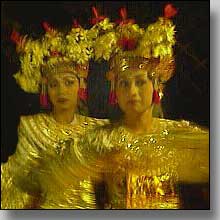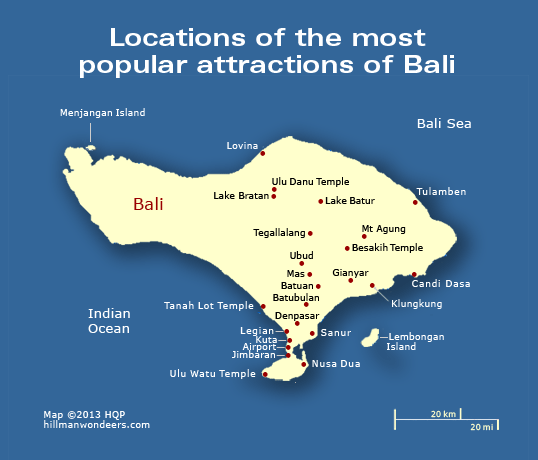Bali dance and music
 Why the dance
and music of Bali
are special
Why the dance
and music of Bali
are specialThey entertain and uplift your spirit. Both art forms have been performed and acclaimed in major cultural centers around the world. Experiencing them in Bali is the ultimate experience.
Dances of Bali
Ramayana
Most Balinese dances relate to segments of the Ramayana, an ancient Hindu epic illustrating the perpetual struggle between good and evil.
Popular dances
The three favorite dances among locals and tourists in Bali are:
-
Barong
A classic dance. Stunning. Depicts the conflict between the good Barong (dressed in a fanciful lion-like costume) and the evil Rangda.
- Legong
Another classic dance. Graceful. Performed by three pre-pubescent girls in colorful attire.
- Kecak (monkey dance)
Although this frenetic dance was not choreographed until the 1930s (and by a Westerner), the Kecak is convincingly rooted in Balinese tradition. Typically, it features 50 to 100 bare-chested men sitting cross-legged in tight concentric circles. They play the role of monkeys, which is why the dance is sometimes called the "monkey dance". As they sway in unison, they repeatedly chant the nonsensical phrase "kechak ke chak" virtually non-stop and without musical accompaniment. They do this in a hypnotic beat to scare away an evil spirit. Several Balinese dancers help dramatize the story.
Gamelan
Nothing is more mesmerizing than the haunting percussion sounds of a Balinese gamelan orchestra. The musicians play an assortment of instruments including native metal gongs, drums, chimes, cymbals and metalophones (xylophones). The counterpointing is exhilarating.
Although a 15 to 30 member gamelan orchestra is the one most associated with "gamelan", many other distinct types exist in Bali. There are marching gamelans – and small-group gamelans that provide music for the Barong and Legong dances.
And, there is the Gamelan Jegog, consisting of two or more floor-seated Balinese musicians playing soft rhythmical melodies on bamboo-based xylophones (Note: Jegog performances are now common in resort lobbies).
Cultural performances
Village performances
Many Balinese villages hold dance and music events for temple ceremonies. Some welcome visitors, providing they discreetly observe.
Tourist versions
Though not as authentic (or lengthy) as the village presentations, there are many one hour Balinese dance and music performances geared especially for tourists. They are staged in hotel or non-hotel settings. Hotel events are integrated with grand buffets.
Most of the non-hotel performances take place in the Denpasar Art Center and in artisan villages such as Ubud and Batubulan (click Bali map to see their locations).
Both the hotel and non-hotel affairs entertain, though those in non-hotel venues are truer to the originals. And, their Balinese performers are noticeably more skilled and talented – and put more of their hearts into their efforts.



